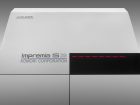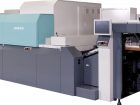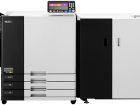
Fujifilm’s Ed Pierce, Komcan’s Brett Rogers, Canon’s Alec Couckuyt and RISO’s Andre D’Urbano describe sheetfed inkjet press advances, challenges, and why commercial printers should invest.
Ed Pierce, Product Marketing Manager, Fujifilm North America, Graphic Systems Division
Why is it important for commercial printers to consider an inkjet press?
Pierce: As run lengths continue to decline, regardless of the reason whether it be inventory cost driven or targeted marketing driven, it becomes increasingly difficult to provide a quality product at a price that is profitable for the print provider. As run lengths decrease, the expectation of quality does not decrease along with it. Toner technologies only go so far and production inkjet drives it home beyond the capabilities of a toner device.
This should also be considered an opportunity for commercial printers. By staying ahead of the curve and investing in new technology that addresses this need; will put the printer in a much better competitive position to attract and win this book of business that is not a trend but rather a new reality in the market. With the integrated technologies of the J Press 720S the print provider can produce a smaller initial quantity and reprint in a week, a month and so on the exact same quality and colour of the initial print run by simply calling up the same job with the same media profile and hitting the print button. There are no plates, there is not running up to colour and there is no extra labour required to reproduce a simple reprint order.
What is currently your company’s best inkjet press for a typical commercial printer?
Pierce: The Fujifilm J Press 720S was not only the first B2/half-size production inkjet press brought to market, it is now in its second generation and the most widely adopted B2 inkjet press with over 100 installations globally.
The J Press 720S uses the industry benchmark Fujifilm Dimatix Samba print heads along with Fujifilm’s cloud-based ColorPath SYNC colour management, Fujifilm VIVIDIA aqueous pigment inks, VERSA Drop jetting technology and proprietary screening algorithms to deliver what many describe as better than offset quality printed output. And by running standard coated and uncoated offset stocks, the commercial printer and print buyer do not have to change the stocks they use or purchase stocks that carry a premium cost.
What key challenges still exist for production inkjet?
Pierce: There is still a perception in the market that production inkjet has yet to achieve offset quality. At least in the case of the J Press 720S from Fujifilm, this market need has been met. Commercial printers tend to look at their current book of business when considering the purchase of a production inkjet press and plugging these numbers into their ROI. The reality is that just about all printers that have adopted production inkjet technology have achieved new business with their investment.
Brett Rogers, Technical Sales Manager, Komcan (Canadian Komori distributor)
Why is it important for commercial printers to consider inkjet?
Rogers: The primary shortfalls of digital printing technologies have been twofold. Volume and Quality, you can maybe have one, but not the other. With production Inkjet, we are seeing that elevated crossover point, and unmatched quality in the digital space.
We have also come to a point with traditional toner-based digital equipment, that quality and other factors such as substrate limitations, and post-press application, are limiting. Inkjet bucks all of those and allows for A) high level of quality, B) continually increasing crossover point, C) substrate freedom (in some cases), and D) post-press durability.
What is currently your company’s best inkjet press for a typical commercial printer?
Rogers: The Komori IS29 is a leader in all four aspects of quality, low to higher volume printing, substrate freedom, and post press durability. The larger format, 23 x 29 inches, allows for 50 percent more up per press sheet, at 8.5 x 11 inches, without sacrificing press speed [3,000 sheets per hour].
Print quality produced by the IS29 is fantastic. Colour consistency throughout the run is solid. Perfecting, UV curing, substrate freedom, including off-the-shelf non-porous substrates, and litho based sheet transport with excellent register, make the IS29 an excellent investment, while maintaining the digital advantages, such as full colour variable. The crossover point is rising.
What key challenges still exist for production inkjet adoption?
Rogers: Preconceptions regarding quality exist because previous incarnations of inkjet technology had shortcomings. This is no longer the case and inkjet printing has now surpassed quality levels seen in the toner world.
Further, the cost of introduction has been an objection heard in the market. The same price objections that were heard when toner based technologies, CtP, or even the Linotype machine came out. Technologies, while in their infancy, are expensive. No different than DVD players, VCRs or 8 Tracks. Inkjet, however, is past the infancy stage, and even past the toddler stage; and as such, improvements are being made, turning these objections obsolete.
Andre D’Urbano, Director of Dealer Sales, RISO Canada
Why is it important for commercial printers to consider an inkjet press?
D’Urbano: For years the print consumer has been told that colour is more expensive. To this day we have organizations that are forced to limit or ban the use of colour as it is deemed a luxury. Inkjet allows those on a budget to shift a majority of their monochrome printed material into the colour arena but at an affordable price. Colour inkjet has a cost of 1 to 2 cents per page and can be sold at 4 to 6 cents per page, a far cry from the 10 to 15 retail cents for colour toner. The end user gains in increased colour printing while the print shop benefits from the higher margins of inkjet compared to monochrome toner.
What is currently your company’s best inkjet press for a typical commercial printer?
D’Urbano: RISO offers production, colour, cut-sheet printing at a speed of 9,600 letter-size pages per hour. The GD9630 offers improved 5-colour output at the low cost that is expected from inkjet. The RISO solution is one of the few – if not the only – high-speed, cut-sheet production devices priced at about $100,000 or less. It is the least expensive way to dip your toe into the inkjet waters. If a print shop has seen the demand for inkjet grow but cannot justify the investment of some of the larger devices in the market, RISO will provide the shallow financial ramp needed to get in the game.
What key challenges still exist for production inkjet?
D’Urbano: Inkjet quality has and continues to be widely accepted by end users everywhere. The challenge comes from those selling inkjet printers along with those at the print shop level who need to sell inkjet printed material to their clients. These are the ones with a critical eye and some cannot get past anything less than toner that is baked onto coated paper. The fact is that there are many non-profit organizations convinced that colour is out of reach. They have for years been told that a colour image will cost more. As such, they revert back to monochrome. A print shop that prints 60 percent monochrome and 40 percent colour annually can easily transfer half that monochrome work to colour inkjet as it is more affordable than toner.
Alec Couckuyt, Senior Director PPSG, Canon Canada
Why is it important for commercial printers to consider inkjet?
Couckuyt: In this rapidly evolving communications industry the commercial printer is faced with five critical dynamics: 1. Shorter run lengths, 2. Faster turnaround times, 3. Increasing job complexity like variable content/images, 4. Expansion of products and services offerings like data management, commercial print, display graphics, fulfillment, and 5. Relentless pressure on cost avoidance. These dynamics dictate the degree of relevance of print within the communications omni-channel venues. Inkjet technology gives the commercial printer an additional critical tool to stay on top of these dynamics and make print highly relevant.
What is currently your company’s best inkjet press for a typical commercial printer?
Couckuyt: The answer has to be twofold – one press does not fit all. If the commercial printer deals with a high number of different types of short run jobs with fast turnaround, an ability to print on a wide range of media, including coated offset, the answer is the VarioPrint iSeries, our highly productive inkjet cutsheet colour press. If the commercial printer’s requirements are based on higher volumes, variable content/images the answer is the ProStream. This 22-inch-wide web press with a native 1,200 x 1,200-dpi multi-level droplet modulation, runs at 80 metres per minute, prints on coated offset media, with a monthly duty cycle of 35 million impressions, and a colour gamut beyond offset.
What key challenges still exist for production inkjet adoption?
Couckuyt: The two biggest challenges a commercial printer faces today are 1) The clear understanding of ink consumption, in order to properly estimate job costs, and 2) The understanding of what paper media a specific inkjet press can print on. It is essential for the commercial printer that during the discovery phase the vendor clearly defines these two aspects.
Print this page



